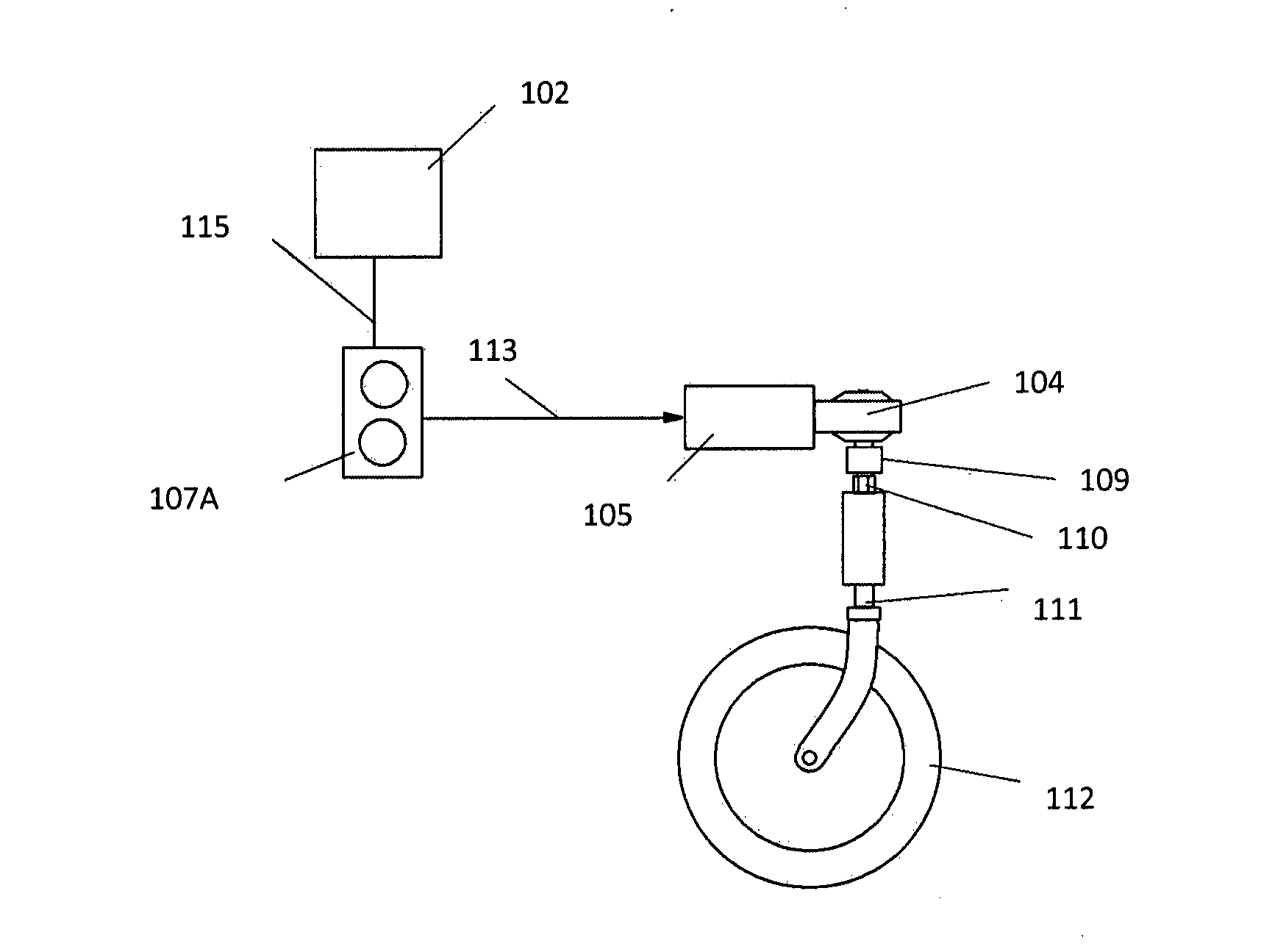Steering control system and method for manual wheelchairs
- Summary
- Abstract
- Description
- Claims
- Application Information
AI Technical Summary
Benefits of technology
Problems solved by technology
Method used
Image
Examples
first embodiment
[0029]FIG. 1 shows a schematic diagram of an electro-mechanical steering system including various components according to a first embodiment. According to FIG. 1, a caster wheel 112 of a manually operated wheelchair is shown. The caster wheel 112 is connected to the body of the wheelchair via a king pin 111. A drive nut 110 is in communication with the king pin 111 and a drive socket 109 is in communication with the drive nut 110.
[0030]On top of the drive socket is located and attached thereto a gearbox 104. Any suitable gearbox may be implemented. For example, the gearbox may be a high ratio worm gearbox. As a further example, the gearbox may be a self locking gearbox that holds its rotational position when the motor is disconnected from the battery or power supply. It will be understood that battery energy consumption may therefore be reduced.
[0031]A motor 105 drives the gearbox 104. Therefore, the motor provides a direct drive mechanism for controlling the caster wheel position.
[...
second embodiment
[0044]FIG. 2 shows a schematic diagram of an electro-mechanical steering system according to this second embodiment.
[0045]As described above in the first embodiment a similar arrangement of a caster wheel 212, king pin 211, drive nut 210 and drive socket 209 are provided along with a motor 205 and gearbox 204.
[0046]According to this embodiment, a clutch mechanism 208 is provided in between the gearbox 204 and drive socket 209. The clutch enables the drive from the motor to be selectively disconnected or disengaged from the caster wheel and so enables the steering control system to be temporarily disengaged from controlling the wheel position. When the clutch is re-engaged, full control of the steering system is then provided. According to this embodiment, the clutch is operated manually by the user in order to connect and disconnect the motor drive from the caster wheel. The clutch may be manually operated by the use of a switch, lever or pedal.
[0047]In addition, according to this e...
third embodiment
[0072]FIG. 4 shows a schematic diagram of an electro-mechanical steering device according to a third embodiment. The same reference numerals as shown in FIG. 2 are shown in this figure where they apply to the same component or signal.
[0073]According to this embodiment, the same system as described in the second embodiment is used except that the system does not incorporate a gyroscopic device to provide a vertical axis rotational signal. Therefore, the system is not able to automatically steer the device without receiving user input, but it is still able to monitor the actual position of the caster wheel via the steering feedback signal from the angular feedback device.
[0074]In order to provide an indication of the problem associated with manual wheelchairs travelling on a camber, FIG. 6 shows a view of a wheelchair travelling on a camber 601.
[0075]FIG. 7 shows an indication of the travel path of the wheelchair along a surface 701 when there is no adjustment of steer 703, and where ...
PUM
 Login to View More
Login to View More Abstract
Description
Claims
Application Information
 Login to View More
Login to View More - R&D
- Intellectual Property
- Life Sciences
- Materials
- Tech Scout
- Unparalleled Data Quality
- Higher Quality Content
- 60% Fewer Hallucinations
Browse by: Latest US Patents, China's latest patents, Technical Efficacy Thesaurus, Application Domain, Technology Topic, Popular Technical Reports.
© 2025 PatSnap. All rights reserved.Legal|Privacy policy|Modern Slavery Act Transparency Statement|Sitemap|About US| Contact US: help@patsnap.com



